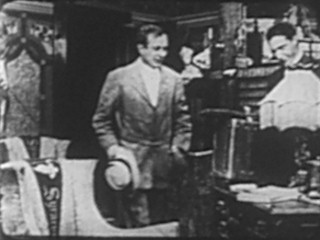Blog Archives
What a Change of Clothes Did (Vitagraph, 1913)
 What a Change of Clothes Did (Vitagraph, 1913)
What a Change of Clothes Did (Vitagraph, 1913)
Directed by Maurice Costello
Starring Maurice Costello and Clara Kimball Young
John Mason (Maurice Costello), a wealthy New York socialite, has grown tired of being sought after and fawned over only for his money. He takes a trip to the country to get away from it all and go fishing. Meanwhile, Joe (Herbert Barry), a man wrongly accused of bank robbery, has escaped from jail and is on the lam. As he’s fleeing, he notices John lazing by the riverbank. Joe grabs a tree branch, quietly sneaks up behind him, and conks John on the back of the head. When John regains consciousness, he discovers his clothes are gone and he’s left with convict stripes.
John, still woozy from the blow, finds his way to the nearest house, which just happens to be Joe’s sister’s (Clara Kimball Young). She knows Joe has escaped and quickly figures out what became of John’s clothes. She offers him some of Joe’s old things, which he gladly accepts. John, not one to take it slow, asks her out on a date, which she gladly accepts.
Joe’s sister doesn’t know anything about John and John isn’t volunteering any information. As far as she knows, he’s a penniless fisherman. Be that as it may, the two hit it off and are married in the next scene. Only then does John reveal his wealth, saying that he was waiting for someone interested in him and not his money.
Oh, and Joe apparently tracked the bank robbers down, followed them to Buenos Aires, and brought them to justice, thus exonerating himself and allowing him to return a free man, but all that happens off-screen.
What a Change of Clothes Did (1913) isn’t an awful film, but it’s about as subtle as being conked on the head with a tree branch. I don’t care for the reliance on incredible coincidences – it’s a sure thing for drawing me out of a story – and I’ll give it the benefit of the doubt and say there’s some time compression going on, but it really does seem like John and Sister just skip over to the Justice of the Peace at the end of their very first date.
On the other hand, I did like all the location shots. This was entering the period when Vitagraph was investing heavily into location-centric films actually shot on the locations they take place in. They had teams going all over the world shooting pictures. Change of Clothes was filmed on Long Island – in Brooklyn-based Vitagraph’s backyard, essentially – but it still feels like they’re making a showcase of the rural backdrop. I also like how the studio interiors actually look like they belong to the location exteriors.
The acting is unremarkable, and I say that as a Costello fan. Again, it isn’t bad, just… perfunctory. It’s surprising, really, given that Costello directed the film himself; I would have thought he would be more invested in it. My favorite character was actually the butler (Richard Leslie), who’s only in two scenes, but he provided a nice, subtle bit of comic relief that made me smile.
In summation…
My rating: Meh.
Available from Harpodeon